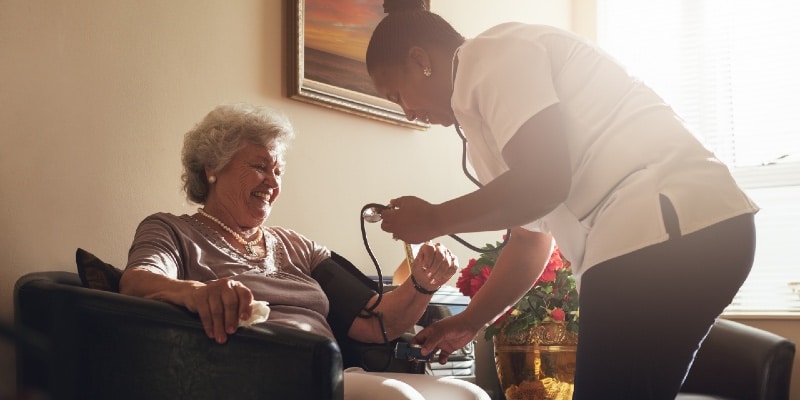Understandably, people do not want to go to a hospital or a doctor’s office in the middle of a pandemic.
Over the past several months, our research has focused on analyzing how COVID-19 may impact adoption of telehealth, which enables health professionals to diagnose and treat their patients remotely via video and audio. But what happens when patients need to access in-person care?
Home healthcare presents a compelling solution. Typically, a primary care provider refers a patient for home health services, and a home health agency reaches out to the patient to set up an appointment. Thousands of home health companies exist, mainly to assist the increasing elderly population in daily activities. But at-home care can also consist of injury treatment, such as wound care, injections, and IV therapy. Several home health agencies are branching into specialized care, such as chronic disease management and mental health services. The US Bureau of Labor Statistics predicts a 36% growth rate in home health aide employment by 2038.
Between the myriad telehealth options and the gradual rise of in-home care providers, we have to wonder: does healthcare have a future outside of the home?
Back to the (healthcare) future
Markets go through waves of centralization and decentralization. When technology is incredibly expensive and so complex it requires special training to be used, it makes more sense to offer its service in one central location where customers can seek out expertise. As technology is simplified, services can be outsourced to less central locations such as the home; the solution can instead be brought to the problem.
Back when medical care was not an advanced practice, healthcare consisted solely of house calls. As medical technology improved, the hospital was born out of necessity. People needed specialized training to use the new technology, so it made sense to provide all services under one roof. But as Disruptive Innovations have begun to make medical technologies simpler to use, care is beginning to move out of the hospital and into alternative locations, such as centers for ambulatory care and urgent care.
Ready, set, go
It’s thanks to this gradual process of decentralization that house-call programs have been able to take off, but COVID has provided an opportunity for them to truly shine.
For instance, Ready Responders (Ready for short) provides in-home medical care in several cities across the country. The company leverages a network of EMTs and paramedics to provide non-emergency care, such as checking vitals and filling prescriptions, while facilitating telehealth calls with physicians over iPad. Despite not planning to begin service in New York City until 2021, Ready approached Governor Cuomo to begin service early when COVID hit, providing in-home COVID tests to New York City public housing residents. Since the onset of the pandemic, Ready has logged more than 15,000 home visits and 10,000 COVID tests a month throughout its service areas.
Taking a patient’s vitals and diagnosing a health condition is no longer so complex that it needs to be done all in one place. Coupled with telehealth platforms that enable patients to consult a licensed physician when an expert opinion is needed, programs like Ready can handle the vast majority of healthcare needs, while improving outcomes for the most vulnerable patients and lowering health costs.
Ready targets Medicaid “frequent flyers”—patients lacking consistent medical care who consequently overutilize the emergency department. New Orleans’ Ochsner Health System, Ready’s first client, saw a 70% reduction in non-emergency ER visits between June 2018 and December 2019 as a result of their partnership. Visiting patients at home also empowers responders to identify possible socioeconomic factors associated with health outcomes, and work to find solutions to those problems. This ranges from acting as a translator to helping patients find a more consistent source of primary care.
It’s worth noting that this model is significantly less expensive for payers. Since Ready generates less overhead than brick-and-mortar medical centers, it can charge $150-$200 for a visit—far less than the average ER visit of $2000. Ready’s model of offering consultations with physicians over telehealth and deploying less expensive medical personnel for in-person care is another way the company reduces costs. Ready’s patients still see improvement through paramedic intervention, proving less-trained personnel are capable of providing high-quality, hands-on care in less demanding situations.
Care doesn’t need to be highly complex, specialist care to benefit high-needs patients. In fact, programs like Ready show that offering basic care inside the home and using physicians merely on a consultative basis lessens the burden on the medical system while also serving the basic health needs of an at-risk population. While healthcare continues to see promising advances in technology, it’s equally exciting to see it evolve in ways that make care delivery far simpler than it currently is.
For more, see:
Can telemedicine thrive beyond COVID?



